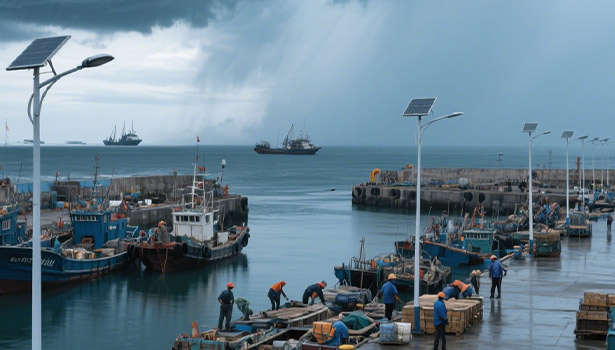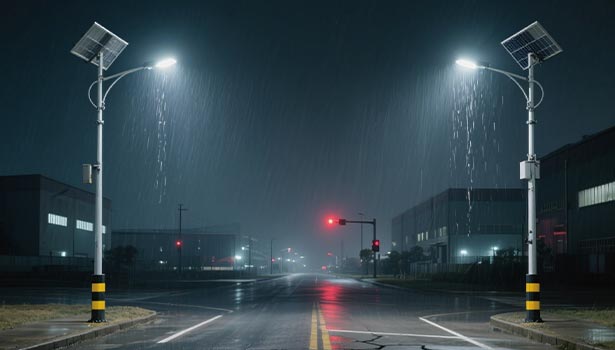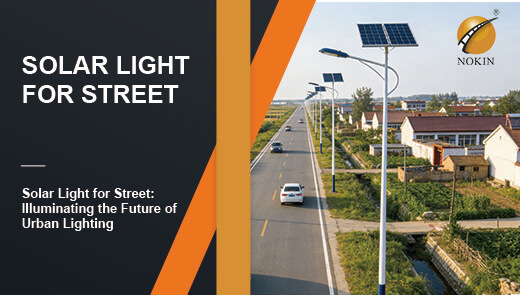Solar Street Lights Not Working After Rain? Here’s How to Fix Them
Solar street lights suddenly malfunctioning after rain is a common headache for many municipal authorities and property management companies. They were working fine just a few days ago, but after a rain shower, they stop responding, which is really frustrating. In fact, there are many reasons why rain can cause solar street lights to malfunction, but most issues can be resolved with simple solutions. This article will provide a detailed analysis of the five most common causes of solar street lights not working after rain, along with corresponding solutions to help you easily resolve this issue.

5 Causes and Solutions for Solar Street Lights Not Working After Rain
Water Ingress
Water ingress is a common reason why solar street lights fail to illuminate after rain. During heavy rain, water may seep into the circuitry or even the battery compartment of poorly sealed fixtures. This issue is typically caused by inadequate sealing during manufacturing or wear and tear from prolonged use, particularly at connection points between the lamp post and fixture, or at the battery compartment seals.
Solution: First, inspect the lamp housing, battery compartment, and wiring ports for cracks or gaps to prevent further water ingress. Then carefully open the lamp and battery compartment, use a soft cloth to dry the internal components, and if necessary, use a hairdryer on cool setting to ensure no moisture remains. Subsequently, use waterproof sealant to reinforce and seal the gaps. If the seals are severely damaged, they must be replaced with new ones. To prevent future water ingress issues, it is recommended to choose solar street lights with an IP65 or higher waterproof rating. Such fixtures can withstand heavy rain without performance degradation due to water ingress.
Insufficient Sunlight
Solar street lights rely on sunlight to charge their batteries, and rainy or cloudy days significantly reduce charging efficiency. It is estimated that clouds block 10%-25% of sunlight, leading to insufficient battery charging. If solar street lights are installed in shaded areas such as building shadows or dense forests, this issue becomes more severe.
Solution: Adjust the position of the solar street lights to maximize sunlight exposure, avoiding shaded areas such as behind tall buildings or under dense trees. Additionally, seasonally adjust the angle of the solar panels to maximize sunlight reception. For example, during winter when the sun's altitude angle is low, the panel angle can be appropriately lowered. In regions with prolonged rainy seasons, consider upgrading to fixtures with larger solar panels or models featuring dual charging functionality (solar and grid-assisted charging) to ensure stable operation.
Dirty Solar Panels
Rainwater does not clean solar panels; instead, it brings dust, dirt, leaf debris, or bird droppings, which can obstruct the panels' ability to absorb sunlight. Over time, this reduces the panels' efficiency and shortens the charging time of the batteries. This issue is particularly pronounced for solar street lights installed at higher elevations that are difficult to clean.
Solution: Cleaning solar panels is a simple yet necessary maintenance task. Use a long pole with a soft cloth dampened in mild soapy water to wipe the panels, avoiding abrasive materials that could scratch the surface. It is generally recommended to clean the panels every 2-3 months, with more frequent cleaning required in dusty or polluted environments.

Battery Issues
The battery is the core component of a solar street light, and like other batteries, it degrades over time. Generally, the lifespan of a solar street light battery is 3-5 years, but exposure to water or improper maintenance can significantly shorten its lifespan, especially for lead-acid batteries, which may develop swelling, leakage, or other issues if exposed to water.
Solution: Open the battery compartment and inspect the battery for corrosion, leakage, swelling, or wear. If issues are detected, replace the old battery with a high-quality rechargeable battery, such as a gel battery or lithium battery. With proper maintenance, these batteries can last 5-8 years. Additionally, for newly installed fixtures, ensure the battery connections are correct to prevent charging issues caused by loose or incorrect wiring.
Sensor Malfunctions
Solar street lights are equipped with light-controlled sensors or human motion sensors to control the on/off function of the lights based on ambient light levels or pedestrian movement. Rainwater and dirt can cause these sensors to malfunction, preventing them from properly turning the lights on or off. For example, if a light-controlled sensor is covered by rainwater, it may mistakenly detect darkness and keep the lights on continuously, leading to battery depletion.
Solution: First, try resetting the light fixture. Typically, there is a reset switch inside the control box of the fixture. Turn it off, wait 10–30 seconds, then turn it back on. This step usually resets temporary malfunctions in the internal electronics or sensors, restoring the system to normal operation.
When inspecting the sensors, block the light sensor with an object to simulate nighttime conditions. If the light does not turn on, the sensor may be faulty or contaminated with dirt. Gently wipe the sensor with a soft cloth to remove dirt or water stains. If the issue persists after cleaning, the sensor may need to be replaced. Contact the manufacturer to inquire about available replacement parts or consider purchasing a more durable sensor model.
How to Protect Your Solar Street Lights from Rain Damage
Choose Good Solar Street Lights
The primary method to protect solar street lights from rain damage is to purchase products with a high IP rating and sturdy construction. Choose models with stainless steel lamp posts, aluminum alloy lamp housings, or durable engineering plastic materials, as these materials can withstand various weather conditions and reduce damage caused by rain.
Regular Check and Care
Regularly inspect solar street lights for damage, especially at seals, wiring ports, and battery compartments. If cracks or gaps are found, consider resealing them with waterproof silicone to prevent water ingress. Additionally, regularly cleaning the solar panels and checking battery status and sensor sensitivity can effectively extend the lifespan of the lights and reduce post-rain malfunctions.
Correct Installation
When installing solar street lights, ensure that the solar panels are oriented toward the direction that receives the most sunlight (typically south), ensuring adequate charging and reducing issues of the lights not illuminating after rain due to insufficient power. Ensure the lamp post foundation is secure to prevent tilting caused by water accumulation, and the lamp base should have proper drainage design to prevent water from accumulating inside the lamp.

What to Check When Buying Solar Street Lights
IP Rating
The IP rating is a key indicator of a light fixture's waterproof and dust proof capabilities. The first digit represents the dust proof rating, and the second digit represents the waterproof rating. In regions with frequent rainfall, an IP65 rating or higher is critical. An IP65 rating completely prevents dust ingress and can withstand low-pressure water jets, making it suitable for heavy rain and other weather conditions. This prevents rainwater from seeping into the interior and damaging the circuitry and battery, ensuring the light fixture operates stably in humid environments.
Material Quality
The material directly affects the durability and corrosion resistance of solar street lights. Stainless steel lamp posts effectively resist rainwater corrosion and are less prone to rust, making them suitable for long-term outdoor use; aluminum alloy lamp housings, after corrosion-resistant treatment, also exhibit good corrosion resistance; high-quality engineering plastics must possess UV resistance and high/low-temperature tolerance to prevent cracking or deformation from prolonged exposure to wind and sunlight. Lamps made from inferior materials are prone to damage after prolonged exposure to rainwater, shortening their service life and increasing replacement costs.
Battery Protection
The battery is the power source for solar street lights, and its protection is critical. Ensure the battery compartment has a good sealing design, including rubber seals and waterproof breathable valves, to prevent rainwater and moisture from entering while allowing gases generated during battery operation to escape. Poor sealing can cause the battery to become damp and corroded, not only affecting charging and discharging performance but also potentially creating safety hazards. A high-quality battery protection design can extend battery life and ensure the luminaire's runtime capability.
Most issues with solar street lights after rain can be resolved through basic inspections. With proper maintenance and wise selection at the time of purchase, solar street lights can remain reliable even in rainy weather. Do you have any tips for keeping solar street lights functioning normally in rainy weather? Feel free to share, or check out our recommended solar street light models with IP65 or higher ratings.




